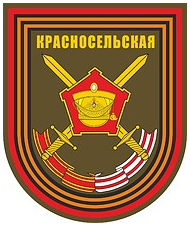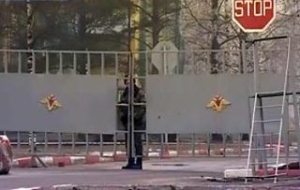Here’s a look at one Russian motorized rifle brigade, created for another purpose, but perhaps worth sharing. The Kamenka brigade’s appeared on these pages before but mainly because of its order and discipline problems.
The 138th Independent Motorized Rifle Brigade (v/ch 02511) is based in Kamenka village, Vyborg rayon of Leningrad oblast. Its full honorific name is the 138th Independent Guards Motorized Rifle Krasnoselskaya Order of Lenin Red Banner Brigade. 138th IMRB for short.

The brigade’s lineage goes to the 45th Guards Rifle Division. That formation participated in the liberation of German-occupied Krasnoye Selo in January 1944.
The division’s regiments (now battalions) received the Leningrad honorific for fighting to lift the German blockade of the city.
The 138th IMRB is part of the 6th Combined Arms Army and the Western Military District.
The following units are subordinate to the 138th IMRB:
- Brigade headquarters
- 667th Independent Guards Motorized Rifle Leningrad Battalion (v/ch 67616)
- 697th Independent Guards Motorized Rifle Leningrad Battalion (v/ch 67636)
- 708th Independent Guards Motorized Rifle Leningrad Red Banner Battalion (v/ch 67661)
- 133rd Independent Guards Idritsa Red Banner Order of Suvorov Tank Battalion (v/ch 52800)
- 486th Independent Guards Self-Propelled Howitzer Leningrad Red Banner Battalion (v/ch 67752)
- 721st Independent Self-Propelled Howitzer Battalion (v/ch 84647)
- 383rd Independent MLRS Battalion (v/ch 82265)
- 1525th Independent Anti-Tank Battalion (v/ch 96459)
- 247th Independent Guards Anti-Aircraft Missile Battalion (v/ch 07727)
- 49th Independent Guards Engineer-Sapper Battalion (v/ch 18427)
- 511th Independent EW Company (v/ch 63704)
- 197th Federal Postal Service Station (v/ch 48768)
- Signal battalion
- Material support battalion
- Maintenance battalion
- Reconnaissance battalion
- UAV company
- Radio-electronic reconnaissance company
- Radiological, Chemical, Biological Defense company
- Medical company
- Commandant company
- Fire control and artillery reconnaissance battery (chief of artillery)
- Reconnaissance headquarters platoon (chief of reconnaissance)
- Fire control and radar reconnaissance platoon (chief of air defense)
- Sniper platoon
- Instructor platoon
- Simulator platoon
- Training ground
- Orchestra
- Radio-television center

Construction of new facilities at Kamenka in 2016
Today’s IMRB should have nearly 4,000 personnel compared to a nominal 2,500-man motorized rifle regiment (MRR). While the maneuver battalions are similar, the IMRB is heavier in fire support, combat support, and service sub-units [подразделения – battalion or lower]. It has two self-propelled howitzer battalions and an MLRS battalion against the single battalion of towed 122-mm D-30 howitzers in Soviet regiments.
The IMRB’s anti-aircraft and anti-tank capabilities are organized in battalions. They used to be single batteries in old MRRs. Most of today’s combat support and service is provided by battalions compared with companies in Soviet times. The old MRR relied more on support and service from the division level.
The 138th IMRB’s motorized rifle battalions have about 500 personnel with about 100 men in each of three companies operating ten MT-LB light armored vehicles. A battalion probably has 31 MT-LBs. The MT-LB is also the prime mover for other sub-units, so the brigade has a significantly larger total inventory, often put at 159 in all. For example, artillery battalions have eight each and anti-tank gun batteries have six.
The 138th is one of several MR brigades primarily using venerable MT-LBs rather than more modern BTRs or BMPs. The 25th near Pskov is another. Others are in mountainous areas of the North Caucasus or in the Eastern MD. The Russian Army may like the MT-LB’s performance in the marshy terrain of Leningrad oblast. At any rate, it’s a simple, reliable armored vehicle that the MOD still has in large numbers.
For integral fire support, each motorized rifle battalion has a battery of six towed 120-mm 2B16 Nona-K gun-mortars in two firing platoons of three weapons. The battalion has a man-portable 9K115 Metis ATGM battery of three platoons of three launchers. The battalion has an air defense battery organized similarly with three platoons of three hand-held 9K38 Igla SAMs.
The 138th IMRB’s tank battalion is outfitted with 41 T-72B3 tanks, ten tanks in each of four tank companies.
The brigade’s two SP howitzer battalions are organized in traditional fashion – 18 152-mm 2S3 Akatsiya systems in three batteries of two platoons with three guns each. The MLRS battalion with 18 122-mm BM-21 Grad systems is similar with three batteries, two platoons of three vehicles.
The brigade’s anti-tank battalion has two batteries of six towed 100-mm MT-12 Rapira guns and six 9P149 Shturm-S ATGMs. The batteries have two firing platoons with three weapons. The anti-tank guns are towed by MT-LBs, and the ATGMs are mounted on MT-LBs.
The brigade SAM battalion has three launch batteries of four 9K332M Tor-M2 SAMs. It has a battery with two launch platoons of three 9A34 Strela-10 SAMs, and probably a battery (two three-vehicle platoons) of older remaining 2S6 (9K22) Tunguska gun-missile systems.
Overall, the 138th IMRB is a pretty average formation that hasn’t been particularly favored with equipment upgrades or modernization.

